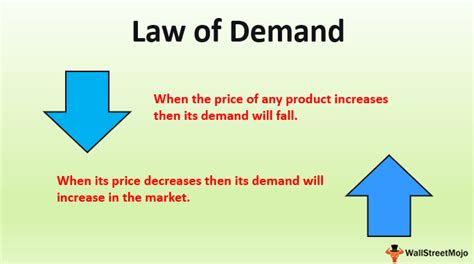The Law Of Demand States That

The law of demand is a fundamental concept in economics that describes the relationship between the price of a good or service and the quantity that consumers are willing to buy. The law of demand states that, all else being equal, as the price of a good or service increases, the quantity demanded decreases, and vice versa. This means that as the price of a product rises, consumers will tend to purchase less of it, and as the price falls, they will tend to buy more.
Understanding the Law of Demand

The law of demand is often graphically represented by a downward-sloping demand curve, which shows the inverse relationship between price and quantity demanded. The demand curve is typically drawn with price on the vertical axis and quantity on the horizontal axis. As the price of a good or service increases, the quantity demanded decreases, and the demand curve slopes downward to the right. The law of demand applies to most goods and services, but there are some exceptions, such as luxury goods or goods with strong brand loyalty, where the demand curve may slope upward.
Factors That Influence the Law of Demand
Several factors can influence the law of demand, including changes in consumer preferences, income, prices of related goods, and population growth. For example, if consumer preferences shift towards a particular good or service, the demand curve will shift to the right, indicating an increase in demand. Similarly, if the price of a complementary good (a good that is used together with another good) decreases, the demand for the original good will increase, shifting the demand curve to the right.
| Factor | Effect on Demand |
|---|---|
| Increase in consumer income | Shifts demand curve to the right |
| Decrease in price of complementary good | Shifts demand curve to the right |
| Increase in price of substitute good | Shifts demand curve to the right |
| Decrease in consumer preferences | Shifts demand curve to the left |

Real-World Applications of the Law of Demand

The law of demand has numerous real-world applications, from pricing strategies to policy decisions. For example, a company may use the law of demand to determine the optimal price for a new product, taking into account the price elasticity of demand and the potential impact on sales revenue. Similarly, policymakers may use the law of demand to evaluate the effectiveness of tax policies or subsidies on consumer behavior.
Criticisms and Limitations of the Law of Demand
While the law of demand is a fundamental concept in economics, it has been subject to various criticisms and limitations. Some critics argue that the law of demand oversimplifies the complexities of consumer behavior and ignores factors such as social norms, cultural influences, and psychological biases. Others argue that the law of demand is too focused on individual consumer behavior and neglects the role of institutions, power dynamics, and social structures in shaping demand.
Key Points
- The law of demand states that, all else being equal, as the price of a good or service increases, the quantity demanded decreases, and vice versa.
- The demand curve is a graphical representation of the law of demand, showing the inverse relationship between price and quantity demanded.
- Factors such as consumer preferences, income, prices of related goods, and population growth can influence the law of demand.
- Understanding the law of demand is crucial for businesses and policymakers to make informed decisions about pricing, production, and resource allocation.
- The law of demand has numerous real-world applications, from pricing strategies to policy decisions, but is subject to various criticisms and limitations.
The law of demand is a fundamental concept in economics that continues to shape our understanding of consumer behavior and market dynamics. While it has its limitations and criticisms, the law of demand remains a crucial tool for businesses, policymakers, and economists to analyze and predict market trends.
What is the law of demand, and how does it affect consumer behavior?
+The law of demand states that, all else being equal, as the price of a good or service increases, the quantity demanded decreases, and vice versa. This means that consumers will tend to buy less of a product as its price rises and more of it as its price falls.
What factors can influence the law of demand, and how do they impact consumer behavior?
+Factors such as consumer preferences, income, prices of related goods, and population growth can influence the law of demand. For example, an increase in consumer income can shift the demand curve to the right, indicating an increase in demand, while a decrease in consumer preferences can shift the demand curve to the left, indicating a decrease in demand.
How do businesses and policymakers use the law of demand to make informed decisions about pricing, production, and resource allocation?
+Businesses and policymakers use the law of demand to analyze the impact of price changes on consumer behavior and to determine the optimal price for a good or service. By understanding the law of demand, businesses can adjust their pricing strategies to maximize revenue and profitability, while policymakers can evaluate the effectiveness of tax policies or subsidies on consumer behavior.



